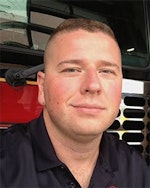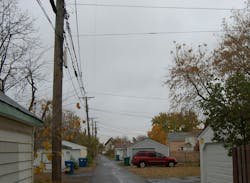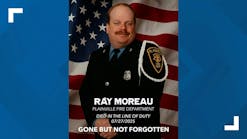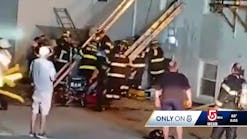Engine Essentials: Alley Garage Fires: Apparatus Positioning, Water Supply & Overhaul for Success
Key Takeaways
- Fire department engine companies that respond to a fire at a garage that’s in an alley must be prepared to stretch longer hoselines from the front of the residence or from where the alley intersects a street.
- Ways for an engine company to obtain a positive water supply to a fire at a garage in an alley are the forward lay, the split lay and the reverse lay.
- Firefighters’ entry into a garage can be complicated because of forcible entry challenges and heavy fire conditions.
Alley garages are extremely common in urban and suburban communities. The structures themselves range from legacy to modern construction and can vary in size to include living spaces. Fires in these structures present unique challenges to responding engine companies, ranging from access and attack line selection, to life safety and fire loads, to exposures and other hazards. Engine company firefighters must devise plans to address these concerns and become proficient through training on the various tactics.
Gaining access
One of the most challenging aspects of alley garage fires is gaining access to the fire. Alleys can be extremely narrow, with tight turns or dead ends. In addition, low overhead wires are common and can present a clearance issue or electrical shock hazard. These factors can reduce or completely prohibit apparatus from entering the alley.
Some situations or department policies may dictate that an engine can’t enter the alley. If the engine is unable to enter the alley, members must be prepared to stretch longer lines from the front of the residence or where the alley intersects a street. The engine’s hosebed should be set up to facilitate efficient long stretches, and members must train on these tactics.
Even if the decision is made to stretch long lines from the address side or end of the alley, access still can prove difficult. Challenges, such as narrow distances between structures, debris/heavy contents in the yard and dogs, can preclude or delay a hose stretch.
Entering the alley
If the engine is able to enter the alley, the task of stretching hoselines often becomes easier due to shorter distances and less obstacles.
The apparatus must be positioned out of the collapse zone and in a manner to prevent heat impingement. Strong caution must be given to overhead power lines that could fail or are already down. Depending on the incident, these factors often can be mitigated by pulling past or stopping short of the garage.
If an engine does enter the alley, the challenge becomes obtaining a water supply. Narrow alleys can prevent additional apparatus from entering and forward laying a supply line to the attack engine. This often results in the supply line having to be laid by hand to the entrance of the alley for another company to complete the water supply.
Water supply: forward lay
There are several effective ways to obtain a positive water supply. The first is the standard forward lay, where an engine lays a supply line from the hydrant to the fire. One way to achieve a forward lay is to have the attack engine lay out from the hydrant, make the turn into the alley and proceed to the fire.
A second way to achieve a forward lay, if space in the alley permits, is to have the second engine lay in from the hydrant to the scene.
The engine company officer must give clear orders to the firefighter who is grabbing the supply line if that member is to remain at the hydrant to make the connection and charge it or if that individual is to remount the apparatus. Depending on the distance, the diameter of supply line being utilized and the required fire flows, it might be advisable to have another engine position on the hydrant to make the connection and pump the supply line.
Water supply: split lay
A second method to obtain a positive water supply is utilizing a split lay. The split lay is very efficient, as the first engine doesn’t have to attempt making the turn into the alley while laying out supply line. When making a sharp turn, the supply line can easily become caught under tires, against vehicles or around sign posts/fences/trees.
To achieve this, the first-arriving engine will drop a supply line at the entrance to the alley and forward lay down the alley. A firefighter dismounts the apparatus and pulls extra line into a pile to provide the necessary weight to begin laying line from the hosebed, or the firefighter can wrap a stationary object or use a strap to keep the line from dragging behind the rig and not playing out. The firefighter can either get back on the apparatus to proceed to the fire or wait to assist with the connection. Similar to the forward lay, communication with the firefighter who is performing the task is a must.
A second engine then can forward lay from the hydrant to the dropped supply line where it makes the connection to feed the attack engine and connects to the hydrant. Depending on the distance, the second engine can position inline to create a relay.
The other option to achieve the splits lay is the second engine can reverse lay from the dropped supply line to the hydrant where it makes the connection and can pump the hydrant.
Water supply: reverse lay
If the alley doesn’t have a dead end or sharp L-shaped or T-shaped turns, a reverse lay can be performed. With a traditional reverse lay, the engine drops the attack hose at the fire and proceeds to the hydrant.
There are several ways to effectively utilize a reverse lay at alley garage fires. The first method is the traditional style, where the crew dismounts the apparatus, selects the appropriate diameter hoseline and pulls the necessary amount to combat the fire. Having a hosebed where members can quickly pull several lengths of hose via bundles and/or stacks is critical. This allows the members to rapidly remove the necessary hose and efficiently stretch it in the confines of an alley.
The driver/operator then drives away from the scene, proceeds to the hydrant, makes the connection and pumps the attack line. If desired, the driver/operator can immediately send tank water for fire attack while making the hydrant connection.
A proactive measure to augment the reverse lay is to lay a supply line in addition to the attack line as the engine proceeds to the hydrant. This allows for the engine to provide an immediate attack line as well as supply an additional engine that may enter the alley. The alley is clear of engine company apparatus, so a second engine can easily enter and be quickly supplied. The second engine allows for additional attack lines to be pulled and alleviates several of the common concerns of the reverse lay: not having enough hose, inability to pull additional attack lines, and losing easy access to tools and equipment that might be needed off of the rig.
If necessary, the reverse lay can be used in combination with a split lay, where the initial engine drops the necessary lines at the fire and proceeds to where the alley intersects with a cross street and stops. An additional engine company can drop a supply line at the attack engine and proceed to the hydrant. Once again, this alleviates having to navigate a tight turn out of the alley while laying lines that could become caught or pinched.
Exposures & fire attack
Frequently, alley garages are in close proximity to other structures, such as dwellings and/or additional garages. In addition, some alley garages are attached to a dwelling despite being located in the alley. This can easily create a major exposure problem, with multiple structures being threatened, necessitating the need for additional alarms or resources.
Garages often contain substantial fire loads from items, such as vehicles, flammable liquids, compressed gases, racked/stored items, etc. This increases the potential for significant fire volume. Couple this with delayed notification to 9-1-1 due to the garage being off of the main street and out of view, and it can easily result in advanced fire conditions on arrival.
Heavy fire loads, advanced fire conditions and exposures require engine company officers to quickly evaluate conditions and make determinations as to the appropriate attack line(s) to be stretched. Consideration should be given to 2½-inch attack lines and/or portable monitors to rapidly knock down the main body of fire. Multiple exposure lines may be needed for protection and to make entry into the exposure buildings to check for extension. If extension is found, the appropriate tactics and resources should be committed to that exposure.
Entry into the garage may be delayed due to forcible entry challenges, such as having to cut garage doors or force fortified service doors. Additional companies should make it a priority to bring forcible entry equipment and saws to the scene. Heavy fire conditions may need to be knocked back prior to forcible entry efforts commencing.
Once entry to the garage is obtained, firefighters must proceed with caution due to the fire potentially weakening exposed structural components that may already have been compromised. In addition, heavy contents may already be overloading the structure or reducing the ability for hoselines to be maneuvered inside of the garage. The majority of fire may need to be extinguished from the safety of the exterior.
Conditions permitting, a thorough search of the garage must be completed rapidly. Firefighters must keep in mind that the garage may contain or have been converted into a livable space. In addition, individuals may seek temporary shelter inside of garages. Tragically, three civilian fire fatalities have occurred in garages in Saint Paul, MN, in 2025 alone.
Overhaul
Once the fire is knocked down, the area must be checked for extension and thoroughly overhauled. Crews must exercise extreme caution, as these structures are often structurally weakened or in disrepair due to age, lack of up keep, weather damage, overloading and, now, fire damage. The number of firefighters who are committed to the structure should be kept to a minimum, and they should only enter after a thorough examination of the structure’s stability. Engine companies can further minimize their risks by utilizing the reach of their hose streams during overhaul and washdown.
Tactics, training, proficiency
Alley garages present unique challenges to responding engine company firefighters. Departments and/or individual companies must develop tactics to safely and effectively combat fires in these structures. Crews must become proficient in their understanding of the challenges that are presented and the necessary suppression techniques through training and district familiarization.

Jonathan Hall
Jonathan Hall, who is a Firehouse contributing editor, has more than 24 years of fire service experience. He currently is a captain with the St. Paul, MN, Fire Department assigned to Engine Company 14. Hall also serves as a lead instructor in the department's Training Division; he teaches hands-on skills to members of all ranks. Hall is the co-owner of Make The Move Training LLC and teaches engine company operations throughout the country.






